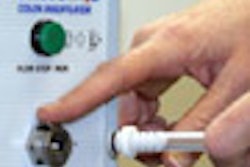CHICAGO - Hybrid imaging with PET/CT for osseous lymphomatous deposits allows physicians to take advantage of the strengths of each modality -- the morphological capabilities of CT and functional capabilities of PET help identify the metabolically active bony lesions in lymphoma patients.
"The osseous lesions seen with primary bone lymphoma account for about 4% of the primary bone tumors" said Dr. Peter Conti, a professor of radiology, clinical pharmacy, and biomedical engineering in the Keck School of Medicine at the University of Southern California (USC) in Los Angeles. "Secondary involvement is common in both Hodgkin's disease as well as non-Hodgkin's lymphoma, and you can see it in about 25% and 20% (of the cases), respectively."
Conti, who is also the director of the PET Imaging Science Center at USC and the immediate past president of the Reston, VA-based SNM, discussed the results of a retrospective study to correlate the metabolic activity and CT appearance of metabolically active metastatic osseous lesions in patients with lymphoma at the 2006 RSNA conference on Monday afternoon.
The researchers reviewed FDG-PET/CT images of 448 consecutive lymphoma patients who were scanned between July 2002 and March 2006. The team found 26 patients in the cohort who had metabolically active bone lesions consistent with either highly probable or definite bony metastases, Conti said. Images from this group of patients were selected for further analysis by the researchers.
The scientists classified all metabolically active bony lesions greater than 1.5 cm into three different morphologic groups using the CT bone window/level (center 300 HU, width 1500 HU): osteoblastic, osteolytic, or presenting no discernible structural lesions
"I always like to remind our residents and fellows in training that just because a lesion doesn't exist on CT that doesn't mean that it doesn't exist," Conti noted.
The means of standardized uptake value (SUV) maximum for these three types of bone lesions on CT were compared two at a time using the Student's t-test (a test for comparing the means of two treatments, even if they have different numbers of replicates).
Conti said that a probability of less than 0.05 was considered significant by the researchers. In addition, he noted that abnormal metabolically inactive bony lesions were also selected and classified as either osteoblastic or osteolytic.
He reported that 46 of the 64 lesions in the 26-patient group were considered to be either probable or definite bone metastases on PET, while 18 of the 64 were CT-positive yet PET-inactive. The researchers found that CT revealed osteoblastic changes in 13 (28%), osteolytic change in 17 (37%), and no structural changes in 16 (35%) of lesions.
The range and mean SUV max were 1.5-17.8 and 7.9 for osteoblastic, 1.6-20.1 and 9.6 for osteolytic, and 1.5-11.2 and 6.4 for no structural change lesions, respectively, they reported.
No statistically significant difference was seen in the metabolic activities among the three categories of lesions, according to the group. Of the remaining 18 CT-positive but PET-negative bony lesions, 14 were found to be osteoblastic and four were deemed osteolytic, Conti said.
"We had FDG uptake in osseous lesions, but it was not predictive of the structural morphology on CT," he said. "More and more we're tending to see this in different types of cancer, not just lymphoma. Approximately one-third of the lesions on PET may not have morphological correlates; so be wary that just because you don't see it on CT, it is, in fact, a real lesion."
By Jonathan S. Batchelor
AuntMinnie.com staff writer
November 28, 2006
Related Reading
Chemo, radiation, and stem cell transplantation effective for brain lymphoma, September 12, 2006
MRI, PET/CT show different strengths in tumor staging, January 20, 2006
Breast cancer risk can be high for Hodgkin's lymphoma survivors, October 7, 2005
PET benefits IWC for non-Hodgkin's lymphoma, June 10, 2005
FDG-PET/CT tops other technologies for lymphoma staging, March 23, 2005
Copyright © 2006 AuntMinnie.com



















